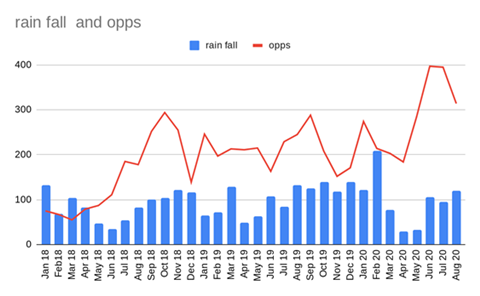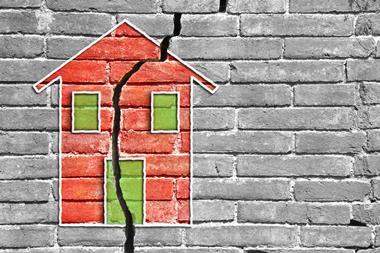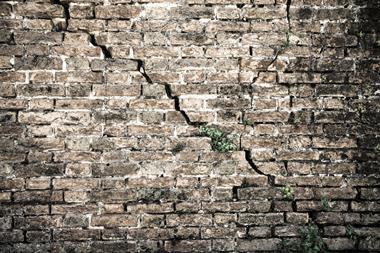Subsidence claims are lengthy and expensive to solve, however Geobear is working with the insurance industry to reduce costs and cut claims down time by 70%
A higher number of subsidence claims than usual has been reported in the UK off the back of an exceptionally warm Spring this year.
This is according to specialist UK technology firm Geobear, who is working to reduce the cost of these claims for the insurance industry.
Subsidence is caused when the ground under a property sinks affecting the foundations of the building, this can increase in hot, dry or drought like weather resulting in cracks in the wall.
While most home insurance policies will cover subsidence damage, the problem Otso Lahtinen, Geobear’s chief executive told Insurance Times is that subsidence claims can be lengthy, expensive and can spike during a surge event.
This is exacerbated by limited resources in the market which means that volumes of early claims settlements are low, therefore brokers often struggle to provide a suitable yet quick solution for customers.
Meanwhile innovation in this area is also limited, with older more traditional methods still being favoured, and this has in turn caused backlogs and longer wait times for customers.
‘A typical year’
With the use of Geobear’s solution insurers are seeing a 70% time saving and a 20% saving in costs.
In a typical year, Alex Finch, commercial director at Geobear said that there are about 10,000 subsidence claims.
“This can jump to around 35,000 if you have what we call ‘a subsidence events year’,” he continued, which is one or multiple events that cause subsidence, he named 2018 and 2003 as subsidence event years.
“2018 for the insurance industry, and particularly loss adjustors was absolutely massive. They are still plodding through those claims now, nearly two years on. It is quite traditional for a claim especially those that involve clay and trees which is about 70% of all the claims particularly in the South East, [for] those claims usually last between 12 and 20 months,” Finch said.

The reason these claims are so time consuming to handle is because of the traditional method used, which is monitor the property’s damage and possibly remove some trees.
This process takes on average a year and a half, but it means that the trees do not take water from the clay, the ground then stabilises, and the repair can then be done.
Geobear’s solution reduces the maintenance down time by injecting a specialist resin into the clay which stabilises it – and it takes a day or two at the most.
This means that the claim can be resolved in three to four months. Geobear has been working with a major UK insurer since winter 2018 and a loss adjustor to do this.
He argued that this is a win-win for insurers as the time spent on the claim is reduced by a year, the cost is reduced, loss adjustors and customers are happier, less trees are removed which is better for the environment and there is less administration.
Slow uptake
Although Finch said that only 6-7% of the market that deal with subsidence claims are using this resin solution, he questioned why the rest of the insurance industry is so slow on the take up.
He said that this was due to insurance as a sector being naturally more risk adverse and favouring traditional methods.
Finch is also a chartered surveyor and previously worked in loss adjusting. Meanwhile Lahtinen has worked at Geobear since he was 12 years old, his family founded Uretek in the 1970s which later rebranded as Geobear in 2017. But the idea for the firm arose when store had a sunken floor and instead an entrepreneur was called into help.
Last year Geobear walked away with Claims Partner of the Year, at the Insurance Times Awards.
Relocation, relocation, relocation
In about 10% of subsidence claims, a homeowner may have to relocate to alternative accommodation while their property is repaired.
However, as Geobear’s solution can be applied within a couple days there are no relocation costs, which can often be more than the actual repair.
“While flooding gets a lot of the press coverage, subsidence can be every bit as disruptive,” Finch said.
When buying a property, potential homeowners can be made aware of these risks in advance by asking for a subsidence risk survey to be carried out.
Unlike flood insurance, home insurance is compulsory when buying a property. “When insurers take on subsidence risk, they have data on postcodes, you [the policyholder] might get higher premiums if you are in a risky area for subsidence, or you might be asked to pay a bigger excess,” Finch added.
However like flood insurance, some property owners may be denied cover if they live in a high risk area.
The South East and Greater London are known subsidence hotspots.
Bottleneck
Most insurers put together a surge plan to prepare for a cascade of events, Geobear suggested that innovation could help here.
Lahtinen said that being proactive by addressing the backlog in subsidence claims could help further down the line by reducing potential bottlenecking when this backlog is combined with a subsidence events year.
Geobear is currently working on two key projects – one being protecting a UK hospital from a sizeable sink-hole as well as a rail tunnel scheme in Northern England.
The firm hopes to challenge intervention in ground engineering, concluded Lahtinen.
Read more…How data is transforming home insurance for a Covid-19 world
Not subscribed? Become a subscriber and access our premium content

Hosted by comedian and actor Tom Allen, 34 Gold, 23 Silver and 22 Bronze awards were handed out across an amazing 34 categories recognising brilliance and innovation right across the breadth of UK general insurance.




















































No comments yet